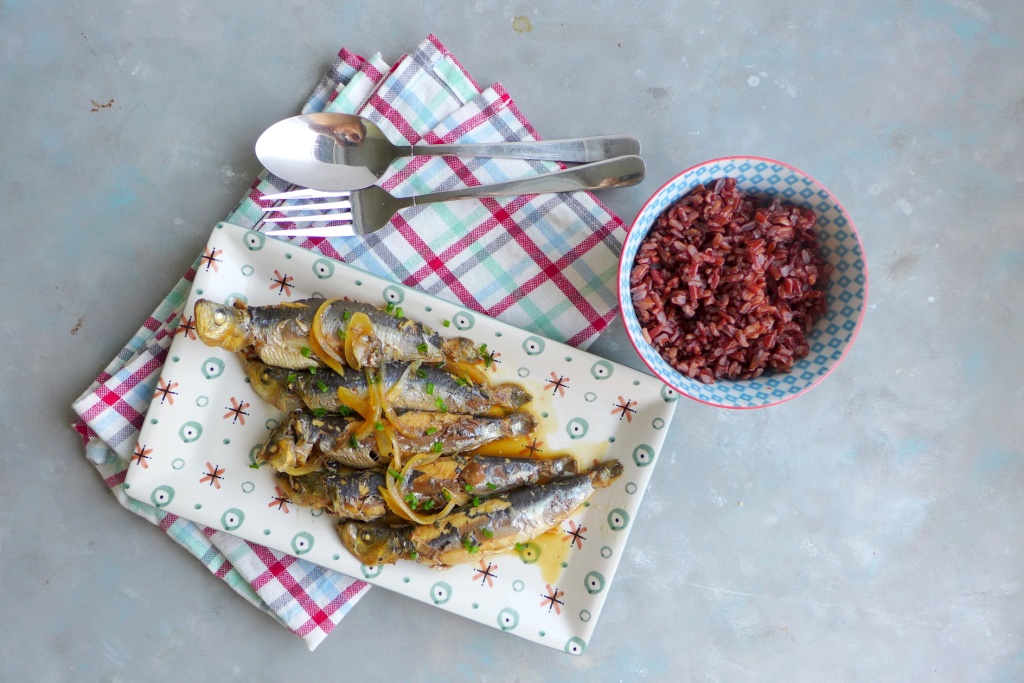Pinamalhan nga isda is the Ilonggo version of paksiw na isda. I grew up eating this regularly. Give it a try!
The only seafood I eat is fish (isda).
I’m allergic to shrimps, I don’t like the smell and texture of crabs and lobsters, and I cannot handle the touch of oysters and its kin.
Growing up, I could eat bangus (milkfish) every single day.
Bangus can be fried, grilled, smoked, added into soup or braised. One of my aunts even called me “Miss Bangus” because of that.
Unfortunately, I haven’t found bangus here in Switzerland. I’m living off some canned bangus cooked Spanish sardines style. Hopefully my stash will last until someone replenishes it as we are not going back to the Philippines this year on account of my being due to give birth anytime now!
So, when I crave some fried or braised fish, I turn to frozen sardines. Sourcing fresh fish here in Switzerland is very expensive, and I found frozen sardines to be a good and cheaper alternative.
They make a good pinamalhan nga isda too!
What is pinamalhan nga isda?

This is the Ilonggo version of paksiw na isda. The main difference between pinamalhan and paksiw is the addition of soy sauce to the braising liquid.
Pinamalhan comes from the Ilonggo word “mala” which means dry. We braise the fish in vinegar, soy sauce, and aromatics until almost dry. I prefer mine to have a bit of sauce though, so I usually stop the cooking process earlier.
We make this with almost any fish, though as stated above, my favorite is bangus, then small tilapia.
I’ve only tried cooking pinamalhan nga isda with sardines here in Switzerland, as that is what is readily available to me. Somehow, I can’t imagine making it with salmon, tuna or the other white fish available in the freezer section. I might be wrong, but for now, I’m totally satisfied with sardines.
They defrost quickly too, due to their small size. It only takes around 20 minutes for them to thaw.
The hardest part of making this dish is cleaning the fish!! The sardines are flash frozen whole to preserve their freshness, which means the guts are still inside.
But fear not. Once you get over the ickiness factor of touching the entrails and gills of raw fish, you’ll do fine.
Let’s start with cleaning some sardines.
First off, descale the defrosted fish. Get a shallow bowl, fill with water and run a small knife against the scales, from tail to head. They should flake off easily. Take care not to put too much pressure these are delicate fish. Rinse well.

Get your descaled fish, the small knife and a chopping board.
(I have a video at the end of this post as well showing exactly how to clean the fish!)

Face the belly of the fish to you and make a shallow incision from the bottom of the head down to a third of the body.

Pry apart the sides of the fish head and use your thumb and pointer finger to remove the gills, and if you are lucky, pull out the rest of the entrails as well.

If they don’t come out, stick your fingers into the incision you’ve made and remove the rest.

Rinse under running water.
Yey! One done. Now move on to the rest.
Once you’ve cleaned all the fish, they will cook in a flash.
Let’s make pinamalhan!

Add all the ingredients in a small saucepan and simmer for 15 to 20 minutes, to the desired amount of sauce left.


Serve with rice!
I like to make more than I can eat at one time because I love this fried too! After spending the night (or a few days) in the fridge, I pan-fry the fish until crispy! Soooo good! No worrying over the bones as they become crispy as well that you can eat them.
I have also made a video on how to cook pinamalhan nga isda!
To save this post for future reference, please pin here:

Other Filipino recipes you might enjoy:
Tweety
Yields 4
Try this Ilonggo version of paksiw na isda.
20 minPrep Time
20 minCook Time
40 minTotal Time
Ingredients
- 400-500 g fresh or defrosted sardines, scaled and cleaned (or other fish of choice)
- ½ c (120 ml) coconut vinegar
- 2 tbsp (30 ml) soy sauce
- 1 medium white onion, sliced
- 5 garlic cloves, crushed
- 1 tbsp (15 ml) oil of choice (I used canola oil)
- 2 tbsp (30 ml) water
- Thumb-sized ginger, sliced
- Salt and pepper to taste
Directions
- Arrange the fish in a small pan.
- Add the rest of the ingredients.
- Simmer over medium heat for 15 – 20 minutes, to desired dryness.
- Serve with rice.
Notes
Note: Leftover fish can be fried until crisp. Serve with chopped tomatoes and rice.




 Save Recipe
Save Recipe

